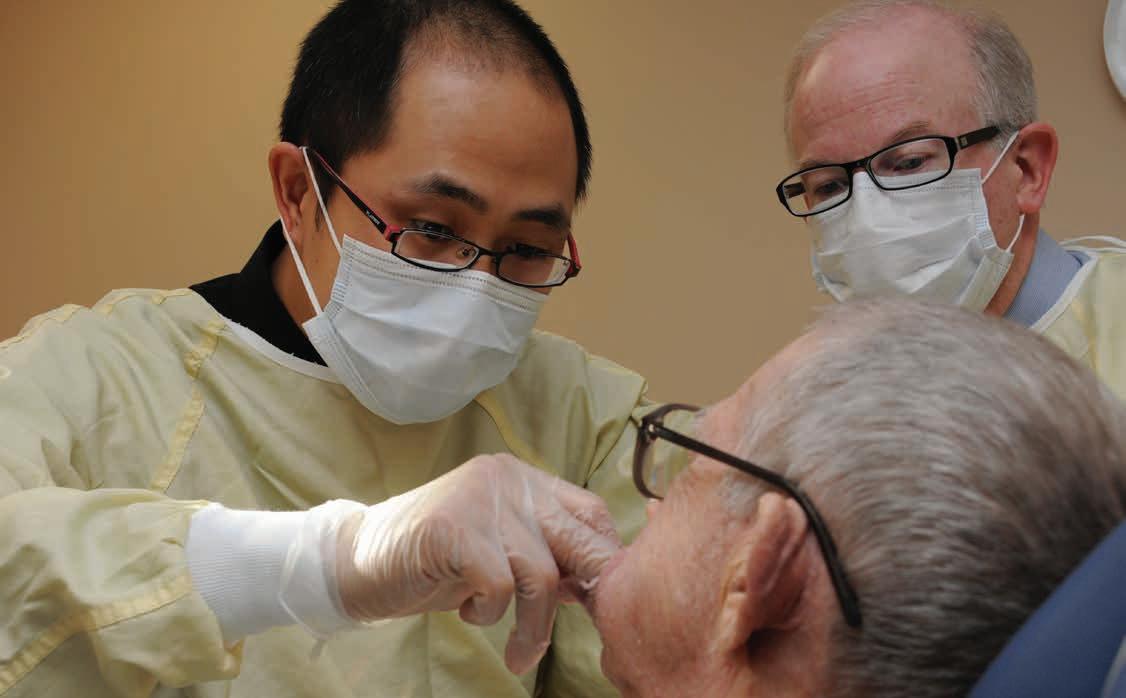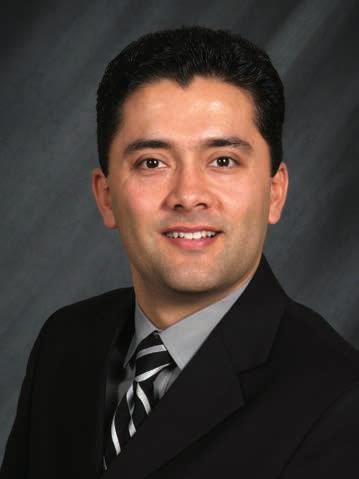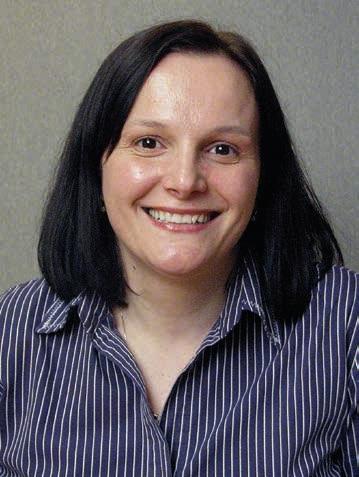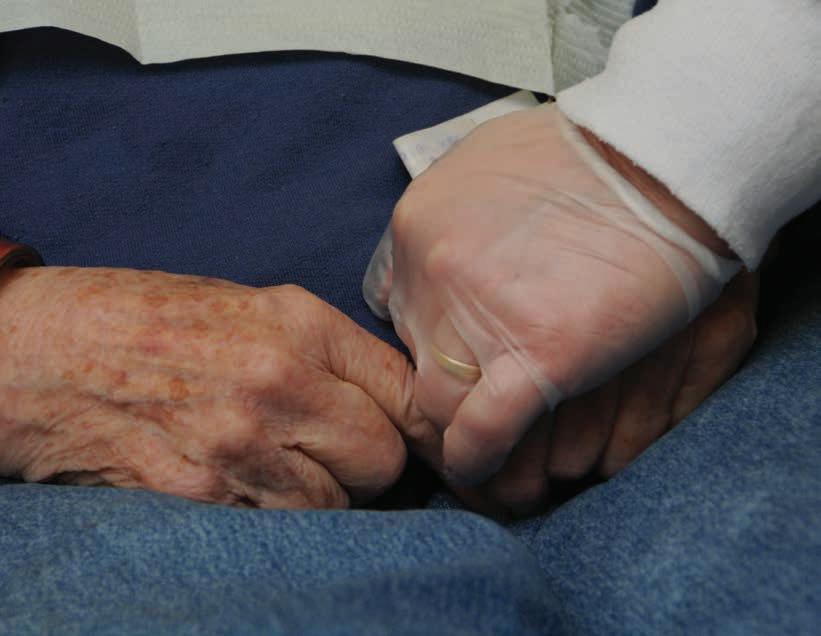
8 minute read
Cover Story
Dental Care for Older Adults a Growing Concern
Eastman at the Forefront in Education, Clinical Care and Research
If I had known I was going to be here this long I wouldn’t have let my dentist pull all my teeth when I was 50.”
This was the lament of an 86 year-old resident of the nursing home at Monroe Community Hospital (MCH) in Rochester.
Her comment has come to be familiar to Director of Dentistry at MCH and EIOH Professor Ralph H. Saunders, Jr., DDS, MS (Gen Den ’80), who, along with other faculty, dental residents and fellows, is working to learn how to best maintain and improve oral health for the growing population of elderly, who are retaining their teeth longer.
A recent report from the American Dental Association’s Health Policy Resources Center quoting data from the National Center for Health Statistics, confirms that the prevalence of edentulism among older adults continues to fall. The report states that older Americans are retaining their teeth more than ever before and will remain susceptible to oral diseases and disorders. That means retired baby boomers, (Americans born during the 18 years following World War II between 1946 and 1964) will require more dental services and likely purchase more advanced services than younger patients.
Although Eastman Dental has always provided care for older adults, a more focused effort in clinical care, education, and research in geriatrics began in the early 1980’s, when all health professions were becoming increasingly aware of the rapid Dr. Saunders and Virginia Weller share a laugh after her dental appointment at Monroe Community Hospital.
Prosthodontic Resident Hai Qing, DDS, treats a patient at MCH while Dr. Saunders supervises.

“I am so grateful to General Dentistry at Eastman. Many doors were opened to me because I was a part of the Eastman family. Thank you for your caring
support.” —Ann Slaughter, DDS, MPH (Gen Den '94)
growth of the elderly population with its attendant needs and challenges. Saunders, working with Stanley Handelman, DDS, former chairman of General Dentistry, received one of the new (at the time) National Institutes of Health (NIH) Geriatric Dentistry Academic Awards, which provided for early personnel development and program growth.
“Dr. Handelman’s foresight and guidance were invaluable in initiating geriatrics activities here,” said Saunders, who is also a professor and the first dentist in the Division of Geriatrics and Aging in the UR School of Medicine and Dentistry’s Department of Medicine. Other faculty and also leaders from the Monroe County Office for Aging and several other local organizations serving older adults joined to form Eastman’s Geriatric Dentistry Task Force which was essential for developing and promoting early activities.
A sequence of other training grants followed which have greatly enhanced opportunities for dental geriatrics in Rochester. At this time Saunders serves as dental director in the UR Interdisciplinary Geriatric Fellowship Training Program for Dentists, Mental Health Professionals, and Physicians; this program is funded by the NIH Health Resources and Services Administration and is in its third renewal period, currently funded through 2015.
Another key factor in the development and growth of geriatric dentistry education has been the opportunity for patientcentered clinical training and also research at MCH, a 566-bed academic long-term care facility. Because about 70 percent of the patients are age 65 or older, rich possibilities exist for learning about interacting with older adults and their caregivers. About four years ago, Saunders worked with dental office professionals to re-design the MCH dental clinic, incorporating state-of-the-art features for comprehensive oral care for older adults with disabilities. All residents in Eastman’s General Dentistry and Prosthodontics programs complete rotations to MCH.
“We are very pleased and fortunate that those who have trained in dental geriatrics in Rochester are making contributions of their own in this field,” said Saunders, who serves on the board of the American Society for Geriatric Dentistry and is a diplomate in Special Care Dentistry.
Like Ann Slaughter, DDS, MPH (Gen Den ’94) for example, who chose Eastman because of a partnership with the Meharry Medical College School of Dentistry, initiated by Handelman, to provide advanced training to graduates who may not otherwise have the opportunity.
“I always had a specific interest in caring for older adults, but this subject had only a minor place in my dental school curriculum,” Slaughter explained.

Ann Slaughter, DDS, MPH (Gen Den ’94)
Dental Issues Facing Older Adults
Susceptibility to Cavities
This was of minimal concern to previous generations of older adults, because few teeth remained. Today, the prevalence of crown caries is about the same as for other adults, but much higher for root surface caries.
Dry Mouth
Estimates vary, but some say up to half of all older adults will get dry mouth, which facilities getting cavities and is uncomfortable.
More Prevention
Because of more physical and cognitive disabilities, older adults have the poorest oral hygiene and greatest need for creative preventive strategies. Encourage older patients to use topical fluoride every day.
Age is Relative
Unless specific medical conditions exist, consider the full range of options when planning.
“My second year at Eastman provided a comprehensive clinical experience targeted to functionally dependent older adults. I also gained experience working with portable equipment in nursing homes, learning to treat patients with a broad range of cognitive and physical deficiencies with compassion and maintaining their dignity.”
After she left Eastman, Slaughter pursued additional training and completed a Fellowship in Geriatric Dentistry at the University of Connecticut and then completed her MPH at the University of Michigan School of Public Health.
“Dr. Saunders’ guidance and expertise and support played a pivotal role in my career beyond the walls of Eastman,” she said. “I have never had a better mentor than Dr. Saunders throughout my formal training and academic career. He has the unique ability, through his gentle and humble manner to want you to build beyond your expectations for yourself.”
For 10 years, Slaughter was on the faculty at the University of Pennsylvania’s School of Dental Medicine as course director for Geriatric Dentistry. There she developed and tested evidence-based, culturally relevant health promotion programs tailored to older African-Americans. Presently, she is working in Philadelphia providing care to nursing homes as an independent contractor. She also holds the distinction since 2008 of serving as the only dentist on the City of Philadelphia Board of Health.
Ricardo Huerta-Andrade, DDS, (Gen Den ’02 and Prostho ’05) completed the Geriatric Dentistry Fellowship in 2007 and said the program allowed him to grow personally and professionally.
“Other than meeting wonderful people and building lifetime relationships, I was glad the experience allowed me to serve the community and to contribute to the increase of scientific knowledge through research,” he said.
Huerta-Andrade, who now practices locally at Ultimate Smile Dental, notes that dentists around the world must be prepared now to care for seniors, because of the explosion in growth of the 65+ segment of the population.
Other EIOH alumni who today continue to make a difference by caring for older adults include Kevin Hendler, DDS (GPR ’88, Gen Den ’89), past president of the American Society for Geriatric Dentistry and now director of Dentistry at the Wesley Woods Geriatric Care Center in Atlanta. Lauren Doss, DDS (GPR ’04) is the Dental director at Canandaigua’s Veterans’ Administration Medical Center, and Jennifer Calnon, DDS (GPR ’11, Fellowship ’12) serves as a VA staff dentist.


Ricardo Huerta-Andrade, DDS (Gen Den ’02, Prostho ’05) This lift allows increased access to care and comfort for older patients who are wheelchairbound, such as Mary Jane Thompson, pictured above.
Research
Many needs exist for research in geriatric dentistry because older adults have historically been studied less than children and other age groups. Saunders has had both leadership and participatory roles in a variety of geriatric research activities.
Early on, he worked with mentor Stanley Handelman investigating older adults’ verbal and nonverbal communication during initial dental visits. His master’s research helped establish the role, now widely accepted, of medications in reducing saliva flow and increasing risk of root surface caries among nursing home elderly.
Working with Eastman Dental Community Dentistry investigators Dennis Leverett, DDS, MPH, and Ronald Billings, DDS, Saunders has served as an NIHcalibrated examiner for surveys of older adults’ oral health and later led an oral health evaluation of a Medicare-supported intervention of homebound elderly. His most recent projects focus on oral healthrelated quality of life of older adults and also education of dentists and dental hygienists in dental geriatrics. In his chapter in a new text, Geriatric Dentistry, Caring for an Aging Population, (ed. Paula K. Friedman, WileyBlackwell, Inc.), to be published in January, Saunders reports on progress in geriatrics education of dental students over the past 25 years.
Training the Future Experts
Current Geriatric Dentistry Fellow Adina C. Jucan, DDS (GPR ’11, GenDen ’12) recently presented her and Saunders’ evaluation of the effect of a nursing home rotation on attitudes of dental hygiene students toward older adults at the American Geriatrics Society annual meeting.
“Caring for older adult is in my heart and this is the fastest growing segment of the population,” said Jucan, whose work has received kudos from Tom Caprio, MD, UR’s director of Geriatrics Training and the Finger Lakes Geriatric Education Center, and Annette Walpole, MD, professor of Geriatrics and Aging and medical drector at The Highlands of Pittsford.
Walpole is researching the value of a new protocol for educating and motivating nursing assistants toward effective daily mouthcare for nursing home residents.
Future of Geriatric Dentistry Education at EIOH
“Although funding for training grants for leaders in education in this non-specialty field of dentistry will remain competitive for the foreseeable future,” Saunders predicted, “continuing to educate our residents in the basics of the theory and practice of geriatric care remains essential, and is now firmly established in the basic EIOH curriculum.”
The history of innovative geriatrics education and clinical care in Rochester and at Eastman combined with the demographic imperative of new generations of older adults, continue to point toward a bright future for geriatric dentistry education. Adina Jucan, DDS (GPR ’11, Gen Den ’12)

Tenderness and compassion are a regular part of treatment at Eastman Dental at Monroe Community Hospital.







